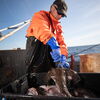A skills/jobs database could offer employment stability for The County
 photo/Becky Shea
Bob Dorsey, president and CEO of Aroostook Partnership for Progress, is waging battle against the notion that there are no good jobs in The County
photo/Becky Shea
Bob Dorsey, president and CEO of Aroostook Partnership for Progress, is waging battle against the notion that there are no good jobs in The County
The long-held perception of Aroostook County — and, to some extent, the state of Maine in general — is that there are no jobs. Or, if there are jobs, they're not very good ones.
The reality, says Robert Dorsey, president and CEO of the public-private group Aroostook Partnership for Progress, is just the opposite. However, that persistent misperception, he argues, is at the heart of the outmigration of Aroostook County's young people, who have come to believe that to find a good job, you have to either leave the county or the state itself.
"It's inevitable that some students will leave the county to pursue certain careers. We need to tackle head on the impression that you have to leave to get a good job," he says.
When combined with an aging work force, this phenomenon is creating a potential vacuum of sorts for the county's employers, many of whom either have or will have positions to fill as their employees retire in coming years.
According to the 2010 U.S. Census, 33% of Aroostook County's 71,788 people were age 55 or older. On the other end of the spectrum, 29% were under age 25. These numbers are similar to Maine's overall population (28.7% 55 and older, 29.9% under 25), but there's more to the story. Between 2000 and 2010, Maine's population rose just over 3.2%, while Aroostook County's fell by that same 3.2%. From an education standpoint, only 16.4% of county residents have a bachelor's or higher degree. That doesn't make for much of a talent pool for companies looking for skilled employees, Dorsey says.
This combination of factors drove Dorsey, who came to APP in January, to realize someone had to do something to stem the outmigration. Since its creation in 2004, APP has helped attract more than 1,000 jobs and $140 million in investment to the region. Its mission is to grow the county's economy, market the region nationally and internationally, create business centers within the region's downtowns and facilitate economic dialog for the region. Now APP is spearheading the Aroostook County Jobs Projection effort, which aims to stem what Dorsey calls a five-decade-old problem.
The goal is to create a database of the county's 50 biggest employers and their projected needs for employees over the next five years. More importantly, the database will also include particular skill sets those companies need, allowing students to get a head start on pursuing specific courses of study.
"The aging work force situation is a real concern, so I'm hoping this will get businesses thinking proactively about their anticipated work force needs so those positions can be filled, hopefully by people from within Aroostook County, or those who've left and may want to come back," Dorsey says.
Hiring challenges
Last year, APP, along with the Northern Maine Development Commission, Loring Commerce Center, Southern Aroostook Development Corporation and Presque Isle Industrial Council, conducted the Business Retention and Expansion survey. Of the survey's 52 respondents, 49 (94%) indicated they expected their employment level to remain stable or increase in the next three years. However, 66% also indicated they have difficulty recruiting new employees. When asked what factors contributed to those hiring difficulties, 80% cited inadequate skills, with 40% citing a labor supply shortage. Not coincidentally, those are two of the main goals of the jobs projection effort.
One of those employers facing difficulty finding candidates with adequate skills is the Aroostook Medical Center, based in Presque Isle and Mars Hill. With a work force of more than 1,000, TAMC is Aroostook County's largest employer, according to Marianne Berube, TAMC's director of human resources.
"Finding skilled clinical professionals who want to stay long-term in Aroostook County is our biggest challenge," she says. "We have challenges in filling specialty clinical positions such as RNs in critical care, critical care transport and emergency services."
Because of the lack candidates with the required skills and experience locally, TAMC is forced to take a scattershot approach to recruiting to attract certain types of employees to northern Maine.
"Physicians primarily come from away, nurses come from both local programs and the Aroostook community, as well as those who are hired from away, and other health care professionals come from both the local community and from outside Aroostook County and Maine," Berube says.
In addition to health care professionals, skilled and seasoned business professionals are also in short supply, which Dorsey says has a negative impact on attracting new business to Aroostook County.
"Over at Loring, they're trying to promote business to come to the old Air Force base. Companies love the infrastructure and the location, but there aren't a lot of MBAs or middle management candidates. With the aging work force, there may be a CFO position to fill, but no folks with the right experience," Dorsey says. "But some of the people who've gone away for school and for work have filled out their resume and have that kind of experience, so it would be great to have them come back."
A fair number of them who would like to come back, but are apprehensive because of that misperception about good jobs in Aroostook County, Dorsey says.
"Every summer, there are class reunions around the county, and you hear people talk about wanting to come home," he says. "But they usually say they plan to do that after retirement because there are no jobs up here. That's what we're up against."
While attracting northern Mainers back to their roots would be good, the overall goal, however, is to make sure fewer of them leave in the first place. According to Dorsey, 70% of the county's high school students surveyed indicated they want to stay, but only if there are good jobs. The hope is that when they have APP's database in hand, they'll realize there are good jobs in Aroostook County. And if they know the skills those jobs require, they'll be able to plan their educational careers.
"I'm hoping that once the information is in a spreadsheet, we'll post it on the website and give it to junior high and high schools first of all to make students aware that there are jobs," Dorsey says. "And when they see the higher salary range of a job, they'll know it requires a bigger skill set and more education. I've had people tell me that for health care, if you wait until your junior year to start planning, it's too late."
If Aroostook County can maintain and grow its population, Dorsey says that stability will lead to more good jobs and provide opportunity for further growth.
"To help our economy grow, it's important to reverse that 50-year downward population trend and attract and retain more residents in Aroostook County to pursue their careers and raise their families here," Dorsey says. "If we can do that, our existing businesses will have a stable customer base that will allow them to continue or grow their businesses."
In addition to the database, APP is hosting a biomass fair at the University of Maine at Presque Isle in May to introduce high schoolers and other young people to some of the available jobs in emerging sectors within Aroostook County. (See "Waste not," on page 24 for more on northern Maine's biomass industry.)
Data collecting under way
The project was launched in March, and is still in the information-gathering phase. Dorsey has been contacting human resources departments to get information on five points: total number of current employees, anticipated number of needed positions in the next five years, desired skill sets to fill those positions, projected income and/or salary range, and whether the company provides benefits. Initially, the hope was to have this database completed and available to this year's high school seniors prior to graduation, but the process hasn't gone as quickly as anticipated.
"It's been a slow start. We've gotten a few responses, but it's one of those admin jobs. You're calling busy people, which means your message ends up in their in basket, so it makes sense that it's going to take several calls to get their responses," he says. "It's probably going to be this summer sometime when we get this finished."
To kick-start the process, Dorsey says he's trying to recruit college students to enter survey information into the database, which should be updated every year.
"Once it's in the database, it's easy to change and update. Building it is scut work, but it needs to be done," he says.
Dorsey says APP plans to engage and recruit college business students to revise and update the County Jobs Projection database. Once the initial database of the largest 50 companies is complete, the students could contact smaller businesses and municipalities to collect their anticipated employment needs. In many ways, he says, this may be an even bigger challenge than the initial data collection.
"Even some of the larger companies haven't been looking that far out, but small businesses tend to work on a 'one in, one out' basis, replacing people as they retire," Dorsey says. "They don't think, 'Whoa, a third of my work force is over 60. I'm going to need people to fill those positions.'"
What employers want
The responses APP has received so far have revealed a wide variety of needs, from people who have electrical skills to service employees. Of particular need are health care workers. Nowhere is that need more pressing than at TAMC, which at the end of April had 46 job openings. In 2011, TAMC averaged 35 to 45 open positions at any given time, Berube says.
"Registered nurses working in a variety of roles make up a large percentage of our work force — approximately 20% — and their skill level is always needed in some capacity," she says. "Physicians and mid-level practitioners — nurse practitioners and physician assistants — are also in high demand and are difficult to find."
The range of TAMC's job listings reflects this trend. Seven of the jobs listed were non-medical positions, and the remaining 39 included eight RNs, eight physicians and five certified nurses' assistants. The hospital's staffing needs could diversify and intensify in the not-so-distant future, as other positions must be filled because of resignations or retirements, Berube says.
"TAMC does have a significant number of employees nearing retirement age over the next 10 years in many positions, specifically lab techs and RNs, as well as a variety of other positions," she says.
Perhaps as much as anything else, Dorsey says communication skills are in heavy demand across the board, which was made apparent through the BRE survey.
"The survey really codified that there's a dire need for people with good communication skills: writing, preparing briefs, speaking skills," he says. "The complaint is that kids can't write, and they can't speak because they're using their thumbs and texting. There's a real concern that we're losing the ability to communicate.
"Even in retail, some of the kids coming in don't have good communication skills. But if you're going to take care of customers, you'd damn well better be able to communicate well," he adds.
The rural nature of Aroostook County, which still depends heavily on farming and forestry, also presents a disconnect for students who are planning out their career paths and may not realize that those jobs, particularly in forestry, have become much more technical and complex, Dorsey says.
"You're no longer giving a kid a hard hat and a chainsaw and taking him out into the woods," he says. "Today, they're operating half-million-dollar machinery with three computers, and it's GPS-guided."
Dorsey acknowledges his motivation is personal. After graduating from Fort Fairfield High School, he spent 26 years in the U.S. Air Force and more than a decade in the private sector before returning to Fort Fairfield in 2001. During high school, he says he didn't get much guidance from the guidance department. Upon his return 40 years later, he was dismayed to see not much had changed.
"I hear a lot that there are a lot of college graduates who can't find jobs, but when I see what their degrees are in, it's not hard to see why," Dorsey says. "The subtle message schools have been sending out is that you need an education, but it's wide open and unfocused. A degree in basket weaving isn't going to do me any good if I need engineers or finance people."










Comments